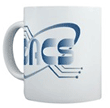| June 5, 2007 General Meeting Review |
| Radio Frequency Identification (RFID) |
Dr. Paul Moskowitz, Research Staff Member at IBM and holder of many U.S. patents pertaining to RFID, told the audience that by the end of the presentation they would all be experts in the field. He delivered on that promise. The first RFID tags described were the passive ones. In its simplest form, RFID technology consists of a semiconductor chip and an antenna with no battery or transmitter. These tags are readable at a distance of up to 30 feet. Some passive tags are battery assisted and can be read at a distance of 100 feet. Active tags, which include batteries and transmitters, have a range of up to 300 feet. From a practical standpoint, someone considering an application of the technology would want to select the least expensive version that reliably provides the desired identification capability. Advantages offered by RFID over bar codes include a unique identification code for each tag, the ability to read many tags almost simultaneously, and that the reader and tag do not need to be in direct alignment. Among Dr. Moskowitz’s contributions to RFID technology is the “Clipped Tag,” a refinement of the design of a tag for consumer goods so that it could be useful, say, to clothing retailers for inventory and checkout, but give consumers the option to remove most of the antenna for privacy. The customer can, upon purchasing a garment, remove a portion of the tag, thereby shrinking the reading distance from 30 feet to 2 inches, still allowing the option for easy product return. Dr. Moskowitz pointed out that the technology needs to match up with the proper business issue. “RFID is not suitable as an anti-theft mechanism for retailing.” Several questions surfaced about personal privacy. Dr. Moskowitz observed that industry needs to make use of the technology in ways that do not alienate people and that businesses are likely to be motivated to use RFID tags in ways that work for their customers. He further pointed out that “there are other technologies that are much better for surreptitious surveillance.” One niche for RFID is computer security: for the person whose desktop work includes restricted data and yet needs to be freely mobile around the office, an RFID device can be installed so that the computer only works for the badge equipped person. One thing that is interesting, among many, about RFID technology is that it has applications that are remote from most people’s lives (tracking of raw inventory for manufacturing), and it has applications that they could encounter on a daily basis (E-ZPass, Speedpass). As the presentation took place and the audience was informed of the types and characteristics of RFID technology, it was stimulated into increased curiosity. By the end of the evening it seemed like everyone in the audience had asked a question! Dr. Moskowitz brought with him an equal abundance of both information and humor. He described his personal experience with an RFID application. With his cats being equipped with RFID tags, most other prospective small visitors are prevented from entering through the cat door. However, he noted, “It doesn’t keep the dead animals out.” Which RFID applications are likely to happen in the near future? High on the list is the management of airline luggage. Anyone who has ever been deprived of a timely reunion with one's luggage at the end of a flight is likely to welcome this. Something people would most likely welcome, though it may not so readily come to their realization, the use of RFID tags to keep track of costly specialized medical equipment in hospitals. Rather than just a handful of staff knowing the location of the equipment is when it is needed, the knowledge of its whereabouts could be almost universal. Having handy knowledge of location could possibly enable a hospital to stock fewer units of the equipment. Grocery checkout, where not only would a customer be able to leave their items in the cart during the process but every item in the cart could be read almost in the blink of an eye, is currently technically possible but not economically viable, but it was certainly fun to see Dr. Moskowitz demonstrate this! No doubt the audience left the meeting filled with thoughts about new applications for RFID. By Chris Novell |
Mugs and more, visit CafePress to order
